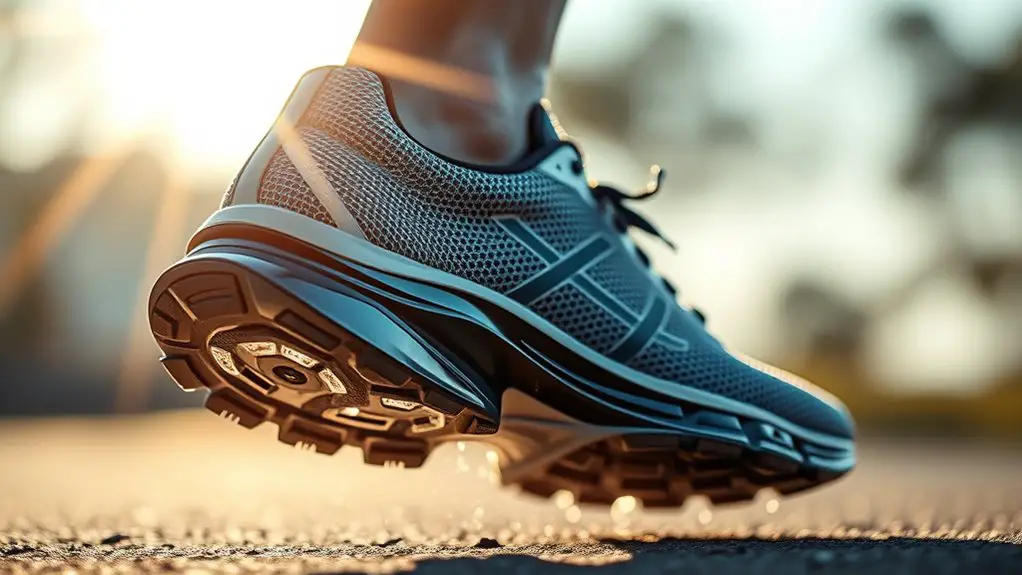High-altitude mask training offers you a unique way to enhance your athletic performance. By simulating low-oxygen conditions, you can boost your endurance, stamina, and lung capacity. This method helps improve your oxygen utilization, making tough workouts feel more manageable. You'll also experience quicker recovery times and greater mental toughness, all while staying in a controlled environment. If you want to discover how to customize this training and stay safe, there's more to learn about its benefits.
Understanding High-Altitude Mask Training
High-altitude mask training is a technique designed to simulate conditions found at higher elevations, helping athletes improve their performance. When you wear a mask, it restricts airflow, mimicking the lower oxygen levels you'd experience at altitude. This forces your body to adapt, enhancing your respiratory efficiency and increasing your red blood cell count over time.
You might feel a sense of freedom in knowing you can train in a controlled environment while still reaping the benefits of altitude training. It's like a shortcut to boosting your endurance without having to travel to high mountains. Plus, using a mask allows you to incorporate this training into your regular workouts, providing flexibility that outdoor training can't always offer. With consistent practice, you'll likely notice improvements in your overall performance, allowing you to push your limits further and experience the thrill of achieving your athletic goals.
Enhancing Endurance and Stamina
While many athletes seek ways to enhance their endurance and stamina, high-altitude mask training offers a unique approach by simulating the challenges of training at elevation. This method pushes your body to adapt to lower oxygen levels, boosting your overall performance. As you wear the mask during workouts, you'll notice improvements in your ability to sustain high-intensity efforts, making those long runs or intense gym sessions feel more manageable. Additionally, incorporating high-intensity interval training can further maximize the benefits of your workouts by enhancing your VO2 max.
Here's a quick look at how high-altitude mask training can enhance your endurance and stamina:
| Benefits | Impact on Performance |
|---|---|
| Increased Oxygen Efficiency | Enhances aerobic capacity |
| Improved Muscle Endurance | Sustains longer workouts |
| Enhanced Recovery | Reduces fatigue |
Boosting Lung Capacity
Training with a high-altitude mask not only enhances your endurance but also plays a significant role in boosting your lung capacity. By simulating the conditions of high altitudes, you're forcing your lungs to work harder, which increases their efficiency over time. This means your body gets better at drawing in oxygen and expelling carbon dioxide, allowing you to breathe deeper and more effectively during workouts.
As you train, you'll likely notice that everyday activities become easier. Whether you're sprinting, cycling, or just enjoying a hike, you'll feel a newfound freedom in your breath. Your lungs adapt to the challenge, expanding their capacity and improving your overall respiratory function. This translates to better performance in sports and a greater ability to push your limits. Additionally, increased red blood cell production enhances your blood's capacity for oxygen transport, further fueling your endurance. So, if you're looking to release your potential and embrace the freedom of movement, incorporating high-altitude mask training could be your key to success.
Improving Oxygen Utilization
As you adapt to the challenges of high-altitude mask training, your body becomes more efficient at utilizing oxygen. This isn't just about breathing harder; it's about transformation. You'll find your muscles learn to extract oxygen from the air more effectively, allowing you to push your limits further. With each training session, you're not just building endurance; you're enhancing your body's ability to perform under pressure.
Imagine running that extra mile or hitting that new personal best without feeling gassed. This increased oxygen utilization means your energy levels remain higher for longer, giving you the freedom to pursue your athletic goals with vigor. As you embrace this training method, you'll realize it's not just physical; it's mental too. The confidence that comes from knowing your body can perform at its peak is empowering. This journey isn't just about training; it's about discovering the true limits of your potential. Additionally, consistent mileage builds aerobic capacity, which is essential for maximizing your endurance and performance.
Accelerating Recovery Times
When you train with a high-altitude mask, you can enhance your oxygen utilization, which plays a key role in speeding up your recovery times. This improved oxygen flow helps reduce muscle fatigue, allowing you to bounce back faster after intense workouts. By focusing on these benefits, you'll find that your overall performance can greatly improve. Additionally, ensuring proper nutrition strategies can further enhance your recovery process and support muscle rebuilding.
Enhanced Oxygen Utilization
Although many athletes focus on endurance and strength, enhanced oxygen utilization can be a game-changer for accelerating recovery times. When you train with a high-altitude mask, your body learns to use oxygen more efficiently, which means you'll bounce back faster after intense workouts. This improved efficiency translates to quicker recovery, letting you hit the ground running sooner.
You'll notice that you're not just gasping for breath during your sessions; you're optimizing every inhale, allowing your muscles to repair more effectively. By reducing downtime, you can enjoy more freedom in your training schedule, exploring new routines or pushing your limits. So, if you're looking to maximize your potential and reclaim your time, consider high-altitude mask training for enhanced oxygen utilization.
Reduced Muscle Fatigue
While training with a high-altitude mask, you'll likely notice a significant reduction in muscle fatigue, which can drastically accelerate your recovery times. By simulating the lower oxygen levels found at high altitudes, your body learns to adapt, becoming more efficient in energy use. This adaptation means your muscles won't tire as quickly during intense workouts. You'll find you're able to push harder and for longer periods without feeling the burn. As a result, recovery becomes quicker because your muscles are less fatigued and can bounce back faster. Embracing this training method allows you to access your potential, giving you the freedom to train harder and enjoy your athletic pursuits without being sidelined by fatigue.
Building Mental Toughness
As you push your limits with high-altitude mask training, you'll discover that building mental toughness is just as essential as physical endurance. This kind of training challenges your mind as much as your body, teaching you resilience in the face of discomfort. Embracing the struggle helps you break through mental barriers and access your true potential. Additionally, practicing mindfulness and relaxation techniques during your training can enhance your ability to manage anxiety and maintain focus under pressure.
Here's a quick overview of how high-altitude mask training can enhance your mental toughness:
| Challenge | Benefit | Outcome |
|---|---|---|
| Increased Resistance | Strengthens mental grit | Greater determination |
| Breath Control | Enhances focus and calmness | Improved performance under pressure |
| Endurance Drills | Fosters persistence | Ability to push through limits |
Customizing Training for Individual Needs
To get the most out of high-altitude mask training, it's crucial to customize your regimen based on your specific needs and goals. Start by evaluating your current fitness level and what you're aiming to achieve—be it endurance, strength, or overall performance. You can adjust the mask's resistance settings to challenge yourself appropriately; this way, you won't feel overwhelmed or underwhelmed.
Incorporate varied workouts, including intervals, long runs, or strength training, to keep things exciting while targeting different muscle groups. Monitoring your progress regularly, tweaking your approach as needed, guarantees continuous improvement. Consider integrating squats and lunges into your strength training routine to enhance your overall lower body strength and coordination.
Don't forget to listen to your body. If something feels off, it's perfectly okay to modify your plan. Tailoring your high-altitude training not only enhances performance but also gives you the freedom to explore your limits, ultimately leading to a more fulfilling and effective workout experience.
Safety Considerations and Best Practices
Customizing your high-altitude mask training is important for performance, but safety should always be a top priority. Start slow, especially if you're new to this type of training. Gradually increase the intensity and duration to avoid overexertion. It's vital to listen to your body; if you feel dizzy or excessively short of breath, take a break.
Make sure your mask fits properly to avoid leaks that can hinder your training. Stay hydrated, since the dry air can lead to dehydration faster than you might expect; proper hydration is essential for optimal performance. Always train in a safe environment—consider using a treadmill or a controlled space if you're unfamiliar with outdoor conditions.
Lastly, consult with a coach or trainer familiar with high-altitude training. They can help you tailor your approach while ensuring you're exercising safely. Prioritize your well-being, and you'll enjoy the freedom that comes with enhanced performance.
Frequently Asked Questions
Can High-Altitude Masks Be Used During All Types of Workouts?
Sure, you can use high-altitude masks during various workouts, but it's important to listen to your body. They can enhance endurance, but if you feel uncomfortable, take a break or modify your routine.
How Long Should I Wear the Mask During Training Sessions?
You might worry about discomfort, but wearing the mask for 20 to 30 minutes during training can boost your endurance. Listen to your body, and adjust the time as needed to stay comfortable and effective.
Are There Any Specific Brands Recommended for High-Altitude Masks?
When looking for high-altitude masks, brands like Elevation Training Mask, Hypoxico, and Training Mask are popular choices. They offer various features, so it's worth checking reviews to find what suits your needs best.
Will High-Altitude Training Improve Performance in Sea-Level Competitions?
Yes, high-altitude training can enhance your performance at sea level. It boosts your oxygen efficiency and endurance, helping you push your limits. Just remember, results can vary based on individual adaptation and training consistency.
Can Beginners Safely Use High-Altitude Masks for Training?
Yes, beginners can safely use high-altitude masks, but start slowly. Listen to your body, and don't push too hard. Gradually increasing intensity helps you adapt without risking injury or overexertion. Enjoy your training journey!




